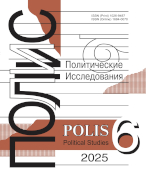Probability Factors of Transborder Spread of Intrastate Armed Conflicts
Golubev D.S.,
Associate Professor, Department of American Studies, Saint Petersburg State University, d.golubev@spbu.ru
elibrary_id: 573869 |
DOI: 10.17976/jpps/2019.02.04
Golubev D.S. Probability Factors of Transborder Spread of Intrastate Armed Conflicts. – Polis. Political Studies. 2019. No. 2. https://doi.org/10.17976/jpps/2019.02.04
The article addresses conditions that affect the probability of spatial spread of intrastate armed conflicts over established national borders. Although some specific factors of this phenomenon are relatively well studied, no prior research has yielded any integrated comprehension of interrelation between these factors and a mechanism through which transborder contagion of organized violence takes place. Moreover, most of prior studies were grounded in such operationalization of contagion that virtually corresponds to the more general process of spatial and temporal clustering of conflicts rather than to conflict diffusion. Hence, the author attempts to reveal and systematize most significant risk factors based on their correlation with potential mechanism of conflict spread. Three groups of such factors are discerned, namely: 1) ones related to the nature of an armed conflict in the source-state; 2) ones characterizing the target-state of contagion; 3) ones revealing the presence or absence of transborder conditions (flows) that function as transmission channels or mediate this effect geographically. In the empirical part of the study, based on re-operationalization of contagion aimed to disaggregate it from a more general phenomenon of clustering, the performance of these factors is tested against the set of observations of spread of armed conflicts in the “post-Socialist” macro-region of FSU and Eastern Europe over the period of 1991-2010. The author argues that, in terms of relative contribution to the process of transborder conflict contagion, the primary role must be attributed to the factors that determine channels and conditions of connection and interaction between a source-state and a targetstate. The latter include refugee flows and other physical cross-border spillovers of organized violence, transnational identity-based ties, and territorial contiguity (shared border) between the two states. Factors that characterize the nature of a source conflict and of a target-state turn out to determine a more general process of armed conflict concentration within specific “unfavorable” regions, and do not directly affect the probability of contagion.
References
Ayres R.W., Saideman S. 2000. Is Separatism as Contagious as the Common Cold or as Cancer? Testing International and Domestic Explanations. – Nationalism and Ethnic Politics. Vol. 6. No. 3. P. 91-113. http://dx.doi.org/10.1080/13537110008428605
Bakke K. 2013. Copying and Learning from Outsiders? Assessing Diffusion from Transnational Insurgents in the Chechen Wars. – Transnational Dynamics of Civil War. Ed. by J.T. Checkel. Cambridge: Cambridge University Press. P. 31-62.
Beardsley K. 2011. Peacekeeping and the Contagion of Armed Conflict. – Journal of Politics. Vol. 73. No. 4. P. 1051-1064. http://dx.doi.org/10.1017/S0022381611000764
Braithwaite A. 2010. Resisting Infection: How State Capacity Conditions Conflict Contagion. – Journal of Peace Research. Vol. 47. No. 3. P. 311-319. https://doi.org/10.1177/0022343310362164
Brubaker R. 2000. Accidental Diasporas and External “Homelands” in Central and Eastern Europe: Past and Present. Vienna: Institute for Advanced Studies. URL: http://www.sscnet.ucla.edu/soc/faculty/brubaker/Publications/19_Accidental_Diasporas.pdf (accessed 26.10.2017).
Buhaug H., Gleditsch K. 2008. Contagion or Confusion? Why Conflicts Cluster in Space. – International Studies Quarterly. Vol. 52. No. 2. P. 215-233. https://doi.org/10.1111/j.1468-2478.2008.00499.x
Cederman L.E., Girardin L., Gleditsch K.S. 2009. Ethnonationalist Triads: Assessing the Influence of Kin Groups on Civil Wars. – World Politics. Vol. 61. No. 3. P. 403-437. https://doi.org/10.1017/S0043887109000148
Cunningham K.G., Sawyer K. 2014. Is Self-Determination Contagious? A Spatial Analysis of the Spread of Self-Determination Claims (August 22, 2014). http://dx.doi.org/10.2139/ssrn.2485190
Fearon J.D., Laitin D.D. 2003. Ethnicity, Insurgency, and Civil War. – American Political Science Review. Vol. 97. No. 1. P. 75-90. https://doi.org/10.1017/S0003055403000534
Forsberg E. 2008. Polarization and Ethnic Conflict in a Widened Strategic Setting. – Journal of Peace Research. Vol. 45. No. 2. P. 283-300. https://doi.org/10.1177/0022343307087185
Forsberg E. 2014. Transnational Transmitters: Ethnic Kinship Ties and Conflict Contagion 1946-2009. – International Interactions. Vol. 40. No. 2. P. 143-165. http://dx.doi.org/10.1080/03050629.2014.880702
Hegre H., Sambanis N. 2006. Sensitivity Analysis of Empirical Results of Civil War Onset. – Journal of Conflict Resolution. Vol. 50. No. 4. P. 508-535. https://doi.org/10.1177/0022002706289303
Horowitz D. 1985. Ethnic Groups in Conflict. Berkeley: University of California Press. 697 p.
Kuran T. 1998. Ethnic Dissimilation and Its International Diffusion. – International Spread of Ethnic Conflicts. Ed. by D.A. Lake, D. Rothchild. Princeton: Princeton University Press. P. 35-60.
Kymlicka W. 1995. Multicultural Citizenship: A Liberal Theory of Minority Rights. Oxford: Clarendon Press. 296 p.
Lake D., Rothchild D. 1998. Spreading Fear: The Genesis of Transnational Ethnic Conflict. – International Spread of Ethnic Conflicts. Ed. by D.A. Lake, D. Rothchild. Princeton: Princeton University Press. P. 3-32.
Maves J., Braithwaite A. 2013. Autocratic Institutions and Civil Conflict Contagion. – Journal of Politics. Vol. 75. No. 2. P. 478-490. http://dx.doi.org/10.1017/S0022381613000157
Metternich N.W., Minhas S., Ward M.D. 2015. Firewall? or Wall on Fire? A Unified Framework of Conflict Contagion and the Role of Ethnic Exclusion. – Journal of Conflict Resolution. Vol. 61. No. 6. https://doi.org/10.1177/0022002715603452
Miller M.K., Joseph M., Ohl D. 2016. Are Coups Really Contagious? An Extreme Bounds Analysis of Political Diffusion. – Journal of Conflict Resolution. Vol. 62. No. 2. https://doi.org/10.1177/0022002716649232
Saideman S.M. 2012. When Conflict Spreads: Arab Spring and the Limits of Diffusion. – International Interactions. Vol. 38. No. 5. P. 713-722. http://dx.doi.org/10.1080/03050629.2012.726186
Salehyan I., Gleditsch K.S. 2006. Refugees and the Spread of Civil War. – International Organization. Vol. 60. No. 2. P. 335-366. https://doi.org/10.1017/S0020818306060103
Toft M.D. 2002. Indivisible Territory, Geographic Concentration, and Ethnic War. – Security Studies. Vol. 12. No. 2. P. 82-119. http://dx.doi.org/10.1080/09636410212120010
Weidmann N.B. 2015. Communication Networks and the Transnational Spread of Ethnic Conflict. – Journal of Peace Research. Vol. 52. No. 3. P. 285-296. https://doi.org/10.1177/0022343314554670
Golubev D.S. 2016. Spatial and Temporal Clustering of Intrastate Armed Conflicts: Alternative Approaches to Explaining the Phenomenon. – Society: Politics, Economics, Law. No. 12. P. 30-34. (In Russ.)
Prokhorenko I.L. 2016. Possibilities of Spatial Approach in Analysis of Ethnopolitical conflicts. – Polis. Political Studies. No. 6. P. 127-138. (In Russ.) https://doi.org/10.17976/jpps/2016.06.09
See also:
Sergeev V.M.,
The terrorism and the problems of the Basque Country. – Polis. Political Studies. 2013. No2
Popov M.E.,
Sociocultural Integration Policy: Major Theoretical Perspectives. – Polis. Political Studies. 2017. No1
Avksentyev V.A., Aksyumov B.V.,
«Clash of Civilizations» in regional aspect: the Caucasus and the Balkans. – Polis. Political Studies. 2007. No4
Svetlov V.A.,
The Georgian-South-Ossetian Conflict. Reflections of a Conflictologist. – Polis. Political Studies. 2009. No3
Abdeeva D.P.,
A decisive factor? Pro-government external interventions in civil wars. – Polis. Political Studies. 2024. No6




.jpg)






 print
print
.jpg)
.jpg)